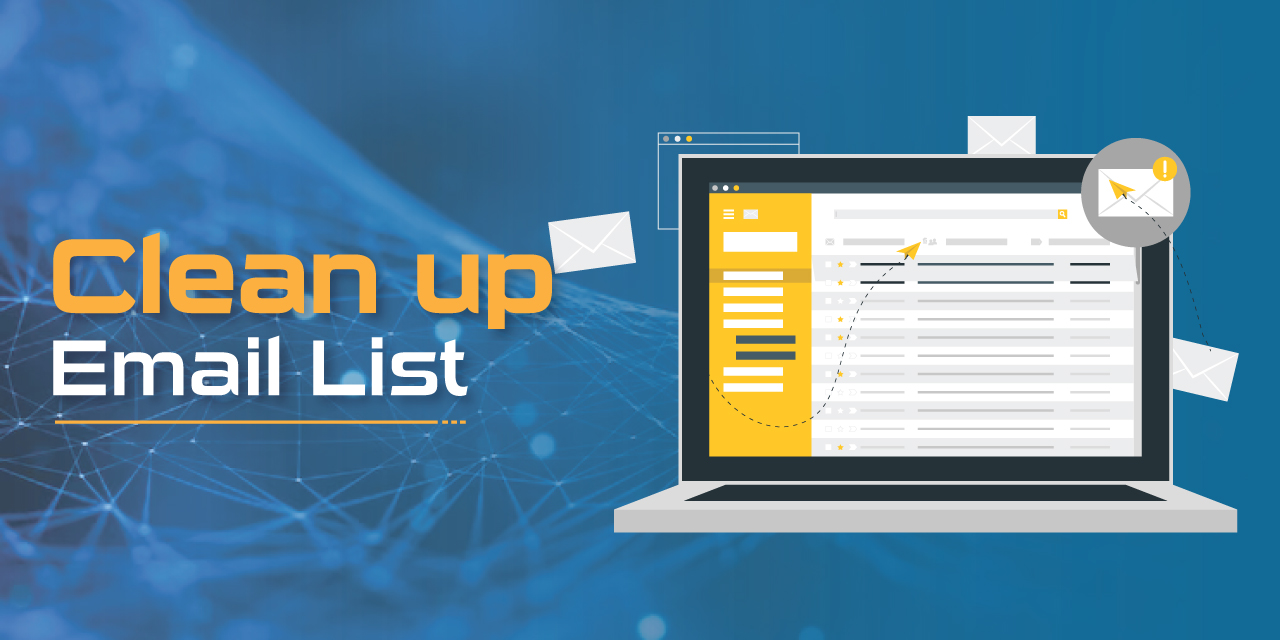
Email marketing is a crucial component of digital marketing strategies and has remained an effective marketing channel for businesses. It offers a powerful and cost-effective way to engage with your audience, deliver your messages, and achieve your marketing goals. It has a strong track record of delivering high ROI and is often regarded as a cornerstone of digital marketing.
To begin your email marketing effort, you'll need to build an email list. By offering rewards to your users, you'll add subscribers and build a relationship with them to improve brand loyalty, deliver messages, and increase sales. Over time, you'll collect a large number of email addresses and there will be fake, spam trap, and invalid email addresses included in your collection. You'll need to clean your email list to maintain a healthy and engaged subscriber base.
What is email list cleaning?
Email list cleaning is the process of removing inactive, invalid, spammy, or unengaged email addresses from your subscriber list. It involves evaluating and purging your email list to ensure that it consists of valid and engaged recipients. As building a mailing list is an ongoing process, it is important to perform email hygiene regularly and maintain a healthy list of subscribers.
What are the risks of not cleaning your email list?
There are many risks associated with having an unclean email list. Here are a few drawbacks of having an uncleaned email list:
1. Reduced email deliverability
If you have too many invalid or inactive email addresses on your list, it can damage your sender's reputation. This can lead to your emails being sent to the spam folder, or even blocked by email providers altogether.
2. Higher bounce rates
Bounce rates are the percentage of emails that are returned to the sender because they can't be delivered. When you have too many invalid or inactive email addresses on your list, your bounce rates will be higher. This can hurt your sender's reputation and make it more difficult to deliver your emails in the future.
3. Increased spam complaints
When people receive emails from senders they don't know or trust, they're more likely to mark them as spam. This can lead to your emails being sent to the spam folder, or even blocked altogether.
4. Legal issues
Someone can potentially sue you for spamming emails if you engage in illegal or unethical email marketing practices. Sending unsolicited commercial emails or violating anti-spam laws can lead to legal consequences. While the specific laws vary by jurisdiction, there are several regulations that govern email marketing activities, such as the CAN-SPAM Act in the United States and the GDPR in the European Union.
What are the benefits of email list cleaning?
Cleaning an email list offers several benefits that can positively impact your email marketing efforts. Here are the key benefits of cleaning your email list:
1. Improved email deliverability
When you have a clean email list, your emails are more likely to be delivered to the recipient's inbox. This is because email providers like Gmail and Outlook use a number of factors to determine whether or not an email is spam, and one of those factors is the sender's reputation. If you have a lot of inactive or invalid email addresses on your list, it can damage your sender's reputation, which can lead to your emails landing in the spam folder.
2. Increased open rates and click-through rates
When you send emails to people who are actually interested in receiving them, you're more likely to get them to open and click on your links. This is because people are more likely to pay attention to emails from senders they know and trust.
3. Lower bounce rates
Bounce rates are the percentage of emails that are returned to the sender because they can't be delivered. When you have a clean email list, your bounce rates will be lower. This is because you'll be sending emails to addresses that are actually valid.
4. Increased ROI
A clean email list can help you to increase your ROI from email marketing. This is because you'll be spending less money on sending emails to people who aren't interested in receiving them, and you'll be getting more engagement from the people who are actually interested in what you are offering.
How do you clean your email list?
Cleaning an email list typically involves several steps to identify and remove inactive, invalid, or unengaged email addresses. Here's a general process for cleaning an email list:
1. Segment your list
Divide your email list into smaller segments based on different criteria such as engagement, demographics, or purchase history. This segmentation allows you to target specific groups more effectively.
2. Remove inactive subscribers
Identify subscribers who haven't engaged with your emails for an extended period, typically over a year. Consider sending a re-engagement campaign to encourage them to interact. If they remain unresponsive, it's time to remove them from your list to maintain good deliverability.
3. Manage bounced emails
Remove email addresses that consistently bounce back. There are two types of bounces: "soft" bounces (temporary issues) and "hard" bounces (permanent issues). Hard bounces, such as invalid or non-existent email addresses, should be removed immediately. For soft bounces, attempt to resend the email after some time or investigate the issue. We offer on online tool to verify email address of your subscriber.
4. Check for spam traps
Spam traps are email addresses created to catch spammers. They are typically inactive and not used by real individuals. Running your list through a spam trap detection service can help identify and remove such addresses.
5. Review subscriber engagement
Analyze metrics like open rates, click-through rates, and conversions to determine the level of engagement with your emails. Remove subscribers who consistently show no interest or engagement with your email.
6. Offer subscription preferences
Provide your subscribers with options to manage their preferences, such as selecting email frequency or choosing specific topics of interest. By doing so, you can reduce the likelihood of unsubscribes and maintain a more engaged list.
7. Conduct regular list hygiene
Make email list cleaning a regular practice to ensure its ongoing health. Remove unsubscribes promptly, review engagement metrics periodically, and address any issues promptly to maintain a healthy list.
8. Use email cleaning services
Consider using email verification and cleaning services to validate email addresses for accuracy and deliverability. There are so many email cleaning companies to choose from, but cleaning services will help you identify and remove invalid or risky email addresses from your list. Some of the email cleaning services include:
- ZeroBounce
- NeverBounce
- MailerCheck
- Kickbox
- BriteVerify
When choosing an email list cleaning service, it's important to consider your needs and budget. Some services offer a free trial, so you can try them out before you commit.
Tips and Tricks for keeping your email list clean
If you have never cleaned your email list, it is highly recommended that you begin immediately. As described in the risks and benefits sections above, there are many consequences of having a bad list. To maintain a healthy list of the mailing list, marketing experts offer the following tips and tricks for keeping your email list hygienic.
1. Use a double opt-in process
Double opt-in is a two-step process used to verify and confirm a subscriber's intention to join an email list. It adds an extra layer of consent and helps ensure that the email addresses collected are valid and owned by the individuals who provided them.
2. Remove inactive subscribers regularly
Inactive subscribers are individuals on your email list who have shown little to no engagement with your emails over a certain period of time. While the specific criteria for identifying inactive subscribers may vary depending on your business and email marketing strategy, they generally include recipients who haven't opened or clicked on your emails within a defined timeframe. By removing inactive subscribers, your email marketing campaign will improve deliverability.
3. Correct typos in the email address
People often mistype their email addresses, and sometimes it is obvious to identify. For example, if someone subscribed to your service with "[email protected]", you can easily correct it to "[email protected]". Similarly, if someone with the name John Doe subscribed with the [email protected] email address, you can correct it with [email protected].
3. Use an email list cleaning service
It may not be easy to identify spammy and spam-trap email addresses. Having those email addresses in your mailing list will hurt your reputation, and potentially flag your service as spam. By using an email list cleaning service, they will help you to identify and remove invalid email addresses from your list.
Conclusion
A smaller but highly engaged email list is more valuable than a large list with low engagement. Monitor your email marketing performance, and identify if there is degrade in your metrics such as open rate, click rate, and engagements. If you see such degradation, you'll know it's time to clean your mailing list.
Be careful about where you collect email addresses. Only collect email addresses from people who have explicitly given you their permission to do so.
It is always hurt to let your subscribers go, but quality always comes over quantity. Having a high-quality list with engaging subscribers will result in better performance and cost-effectiveness, and lower your risk of ruining your reputation. Regularly cleaning your email list helps improve deliverability, reduces the risk of being marked as spam, and ensures that your messages reach the right audience.
Share this post
Leave a comment
All comments are moderated. Spammy and bot submitted comments are deleted. Please submit the comments that are helpful to others, and we'll approve your comments. A comment that includes outbound link will only be approved if the content is relevant to the topic, and has some value to our readers.




Comments (0)
No comment